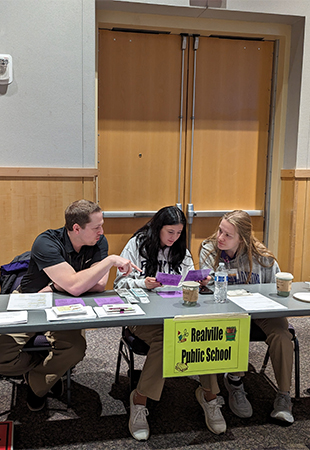IPE/IDE fosters cooperation, empathy for future professionals navigating systemic issues
News
In the College of Health and Behavioral Studies (CHBS), collaborative and innovative experiences are implemented daily to strengthen both knowledge and practical skills for future health and human service providers. One way students are prepared for collaborative practice is through Interprofessional and Interdisciplinary Education (IPE and IDE), which provides courses, workshops and seminars for undergraduate and graduate students at CHBS.
Interprofessional and Interdisciplinary Education “brings together students from two or more professions or disciplines,” allowing them to learn about, from and with each other as part of their “training and education,” describes Vesna Hart, Associate Director of Interprofessional and Interdisciplinary and Programs.
Interprofessional education cultivates “collaborative practice so that health professionals work with each other for the benefit of the patient,” said Hart. “Research has proven that when multiple health professions work together, it leads to improved quality of patient care, it decreases length of stay in hospital, it reduces cost of care, and there are fewer medical errors.”
 “What one profession does, it may not be as effective unless they are collaborating with another profession, said Hart. “It’s not only knowing about one’s own professional identity, but understanding how to work and what to expect from other professions and disciplines.”
“What one profession does, it may not be as effective unless they are collaborating with another profession, said Hart. “It’s not only knowing about one’s own professional identity, but understanding how to work and what to expect from other professions and disciplines.”
Interdisciplinary Education has a broader application, and involves knowledge development and inquiry, and solving complex problems. “We find better solutions to problems when we look at them from multiple disciplinary perspectives,” said Hart.
During the Life in a State of Poverty Simulation, organized by IIHHS every semester, students learn what it’s like to meet the needs of all family members as a low-income family. The simulation seeks to sensitize students to the impacts of poverty as well as the systems and organizations low-income families navigate, in order to strengthen their understanding of the roles and responsibilities they might fulfill in their future careers as they support or interact with low-income individuals.
“Poverty itself is a huge problem,” said Hart, “It’s not just a problem of one profession, one family, one community. It’s a national and global problem.”
“One aspect of [the simulation] is [developing] empathy, but the end goal is to understand how systems work, how individuals get impacted by community agencies and policies, and what one’s role as a future professional might be working with that population,” said Hart.
In the Life in the State of Poverty Simulation, students assume a role of a family member. Families can vary in sizes and needs, including multigenerational households and families experiencing homelessness. Students work together in groups, as family members of their assigned family, to navigate different systems and agencies, such as social services, schools, daycare, employment, mortgage and utility companies, and banks, to meet the needs of their assigned family.
“There are long lines at certain stations,” said Hart. Students are given insight into how low-income families utilize limited resources, including time. “The stress of not being able to accomplish everything really kicks in.”
Over the February sessions of the simulation, 180 students participated, and 52 faculty, staff, and graduate students volunteered at the event to operate the different stations representing community agencies and organizations. “It’s a big effort to pull all of it together,” said Hart.
Hart hopes students who participate in the simulation “develop an understanding that many professions have value and a role in addressing poverty that their own profession does not have capacity to do alone.”
“In those three hours of the simulation, students get the experience of living in economically challenging conditions. My hope is that the experience itself will be more etched in their memory than a lecture,” said Hart. “My hope is that it will make them better professionals, better people in general in how they approach issues of economic inequity.”
